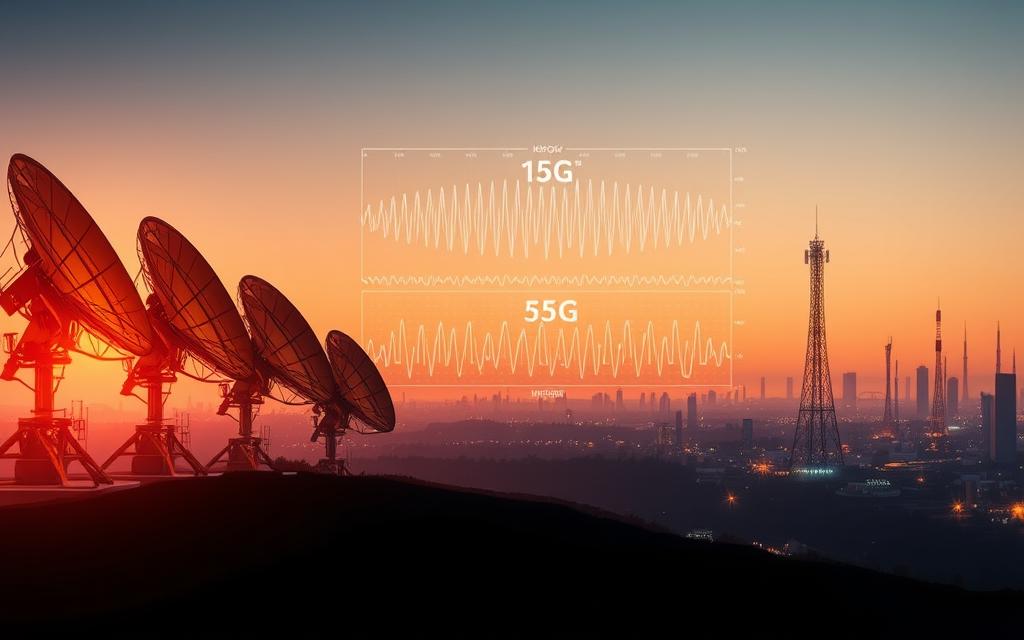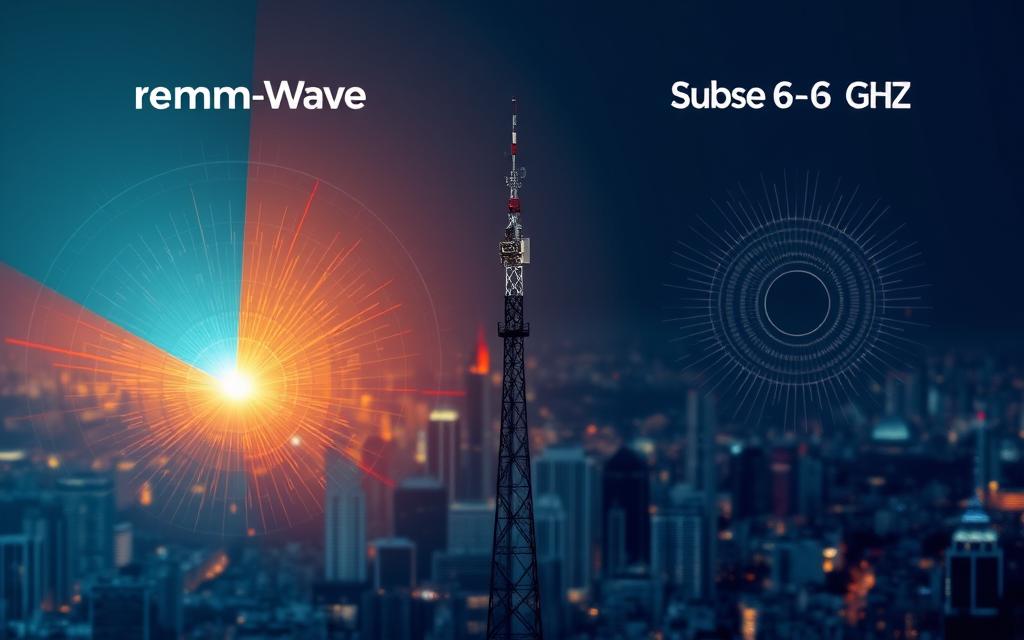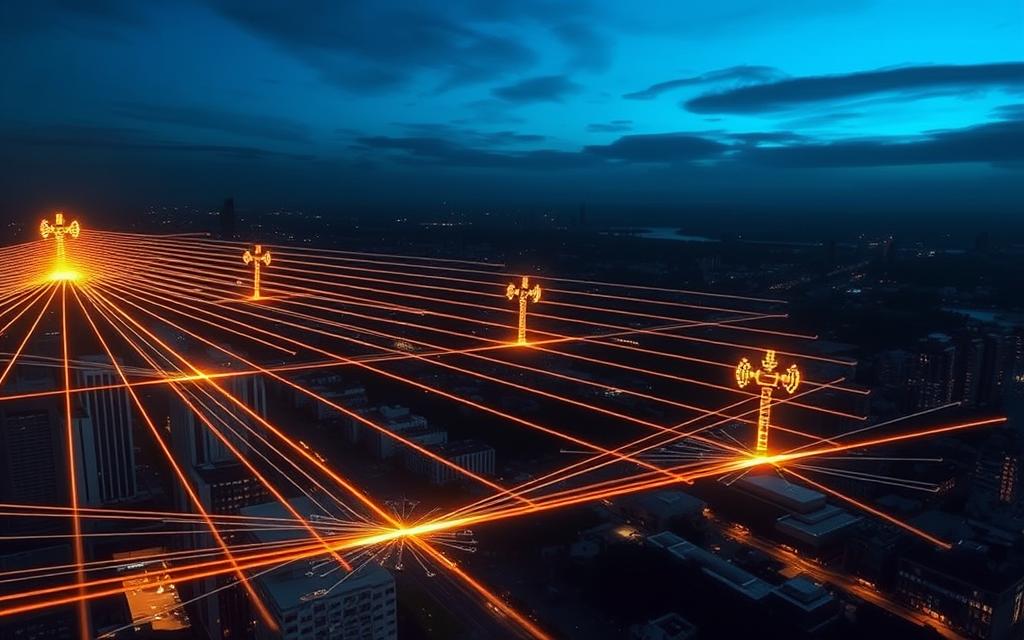Welcome to the world of next-generation connectivity. High-frequency 5G is a big step forward in mobile communications. It uses the millimetre wave spectrum, with frequencies from 24 GHz to 100 GHz, for top performance.
Unlike old cellular bands, mmWave technology is at the top of the radio spectrum. It has huge bandwidth for fast data transfer. This is perfect for things that need very low delay and super-fast speeds.
This technology is key for advanced 5G networks around the world. It supports new experiences like augmented reality and self-driving cars. It’s at the forefront of today’s telecoms.
What Is mmWave Technology?
Millimeter wave technology is at the forefront of wireless communication. It uses frequencies that older cellular networks never reached. This new method of data transmission is a key part of 5G networks. It brings speeds that change how we connect and talk to each other.
Defining mmWave and Its Frequency Bands
Millimeter waves are in the radio spectrum from 24GHz to 100GHz. This range is known as high-band 5G. The name “millimeter” comes from the short length of these signals, between 1 and 10 millimetres. They are different from the usual wireless signals with longer wavelengths.
Each country has its own frequency bands in this spectrum. In the US, the Federal Communications Commission has allowed several bands between 24GHz and 47GHz for 5G. Other countries have done the same, making a global plan for high-band 5G.
“Millimeter wave spectrum represents the frontier of wireless innovation, with bandwidth capacities much bigger than before.”
These high frequencies offer a lot more bandwidth than lower frequencies. While sub-6 GHz bands have 100 MHz, millimeter waves can have over 800 MHz. This means they can offer speeds in the multi-gigabit range, which is what makes 5G so fast.
There’s often confusion between mmWave and 5G. Millimeter wave is about the specific radio frequency bands used. 5G is the cellular technology standard that uses many spectrum bands. Not all 5G uses mmWave, but all mmWave is part of 5G.
| Frequency Range | Classification | Primary Use Cases |
|---|---|---|
| 24GHz – 40GHz | Lower mmWave Band | Urban 5G deployment |
| 40GHz – 70GHz | Mid mmWave Band | Fixed wireless access |
| 70GHz – 100GHz | Upper mmWave Band | Experimental applications |
Looking at frequencies from 24GHz to 100GHz, it’s clear why this spectrum is so important. The bandwidth here allows for data rates that were only possible with fibre optic cables. This makes wireless gigabit speeds a reality for mobile users.
How mmWave Fits into 5G Networks
Before 5G, millimetre wave spectrum was key in communication systems. It’s a big step up from old cellular standards. It brings new powers to mobile connections.
Historical Context and Development
Millimetre wave frequencies were first used for special tasks, not phones. For years, they helped with satellite and military radar. They were great for moving big data fast.
Satellite operators used mmWave for sending data to Earth. The military and aviation loved it for its sharp detection. These uses showed mmWave’s power before phones.

Turning mmWave into 5G was a big challenge. Engineers created new ways to send signals. They used advanced antennas and beamforming to solve signal problems.
As data needs grew, mmWave’s future looked brighter. It went from special use to everyday mobile tech. This change was huge.
Now, 5G uses all the learning from mmWave. The tech from satellites and radar helped make 5G better. This history keeps improving 5G’s speed and reliability.
How mmWave Fits into 5G Networks
Sub-6 GHz frequencies are the mainstay of 5G networks. But mmWave technology is the cutting-edge innovation. It unlocks capabilities that truly differentiate 5G, opening new possibilities for everyone.
The Role of mmWave in Enhancing 5G Speeds
Millimetre wave technology is the heart of 5G’s impressive performance. It offers vast bandwidth for unprecedented data transmission rates. These rates were once unimaginable in wireless networks.
Unlike lower-frequency spectrums, mmWave has vast unused radio space. This allows for wider channels that carry more information at once. You get gigabit speeds that can reach 10 Gbps under the best conditions.
These speeds change what’s possible with mobile connectivity. Downloading HD movies takes seconds, not minutes. Streaming 8K video is seamless without buffering.
mmWave also helps achieve ultra-low latency. It reduces response times to mere milliseconds. This is key for applications where delays are a problem.
According to industry research, mmWave’s high bandwidth and low latency enable new use cases. Autonomous vehicles can communicate in real time. Surgeons can perform remote operations with precision.
| Performance Metric | Typical 4G LTE | Sub-6 GHz 5G | mmWave 5G |
|---|---|---|---|
| Peak Download Speed | 100 Mbps | 1-2 Gbps | 4-10 Gbps |
| Latency | 30-50 ms | 10-20 ms | 1-5 ms |
| Available Bandwidth | 20 MHz chunks | 100 MHz chunks | 800 MHz chunks |
| Simultaneous Connections | Thousands per cell | Tens of thousands | Millions per km² |
The table shows mmWave’s dramatic leap forward. It doesn’t just improve mobile experiences. It enables new applications that need massive bandwidth and fast response.
As 5G networks evolve, mmWave’s role will grow. It’s not for every scenario but is key for high-density areas and special applications needing extreme performance.
How mmWave Fits into 5G Networks
mmWave is at the forefront of 5G technology. Yet, its use is different from lower frequency bands. It needs careful planning due to its unique features compared to sub-6 GHz.
Comparison with Sub-6 GHz 5G
mmWave and sub-6 GHz 5G differ in frequency and performance. Sub-6 GHz works below 6 GHz, covering more areas and going through buildings well. They’re great for wide network coverage in cities and countryside.

mmWave, on the other hand, uses frequencies from 24 GHz to 100 GHz. It offers super-fast speeds and lots of capacity but has a shorter range. This makes choosing between coverage and speed key in network design.
“The choice between mmWave and sub-6 GHz isn’t about superiority, but appropriate application based on specific use cases and deployment environments.”
Designing 5G networks requires balancing these factors. Sub-6 GHz provides wide coverage, while mmWave excels in high-demand areas. This mix ensures reliable and fast service for all users.
| Feature | mmWave 5G | Sub-6 GHz 5G |
|---|---|---|
| Frequency Range | 24-100 GHz | Below 6 GHz |
| Maximum Speed | Up to 10 Gbps | Up to 1 Gbps |
| Coverage Range | 200-500 metres | Several kilometres |
| Building Penetration | Limited | Excellent |
| Ideal Use Case | Dense urban areas | General coverage |
How spectrum is allocated affects where mmWave is used. Rules guide which frequencies are used for what. This has pushed mmWave to meet growing needs.
In cities, mmWave is perfect for areas with lots of people. Places like stadiums and transport hubs are ideal for mmWave. They work well with the wider sub-6 GHz network around them.
Benefits of mmWave Technology
mmWave technology brings huge performance boosts to 5G. It goes beyond what we’re used to. Now, let’s see how it benefits us.
Ultra-High Speeds and Low Latency
mmWave is known for its incredible data transfer rates. It’s way faster than old networks, reaching speeds in the Gbps range. This is 10-100 times faster than before.
Latency, or the delay in data transfer, is also greatly reduced. mmWave makes this delay almost invisible, taking it down to single-digit milliseconds. This makes real-time applications possible, where quick responses are key.
Imagine using augmented reality that works instantly. Or robots in manufacturing that move with perfect timing. These need both fast data transfer and quick responses.
“The sub-millisecond latency of mmWave networks creates opportunities for synchronisation that simply didn’t exist before.”
In transport, mmWave is vital. For autonomous driving, it’s essential for cars to talk to each other and the world around them. This way, they can share vital information instantly.
Healthcare also gains a lot. Remote surgeries need fast, reliable connections. mmWave makes these surgeries possible by providing the needed speed and low latency.
mmWave’s fast speeds and low latency open up new possibilities. It doesn’t just make things faster. It lets us do things we couldn’t before.
Unlocking Urban Connectivity: mmWave’s Capacity Revolution
mmWave technology has changed how we connect in busy cities. It makes networks work better in places where old systems struggle. This is a big deal for cities full of people and devices.
Solving the Urban Congestion Challenge
Big cities are hard on wireless networks. Lots of devices fight for space in a small area. This causes problems during busy times.

Think of old spectrum like a narrow road. mmWave is like a wide highway. It lets more devices connect at the same time.
To make it work, cities use small cells. These small transmitters cover areas where lots of people are. They make sure everyone gets good service.
| Spectrum Characteristic | Sub-6 GHz Networks | mmWave Technology |
|---|---|---|
| Available Bandwidth | Limited channels | Extensive unused spectrum |
| Devices Supported per Cell | Hundreds | Thousands simultaneously |
| Ideal Deployment Scenario | General coverage | High-density zones |
| Congestion Management | Bandwidth sharing | Dedicated channel allocation |
mmWave is really useful in certain places:
- Stadiums and venues: Thousands of people can watch videos without any problems.
- Transportation hubs: People can stay connected while moving around.
- Business districts: Businesses can run smoothly even when it’s busy.
- Smart city infrastructure: Devices can send data all the time.
mmWave does more than just help with connectivity. It makes new things possible. Like using augmented reality in the streets or working together in high-definition video in crowded places.
As cities get more crowded, mmWave becomes even more important. It helps create new ways of living and working where technology doesn’t hold us back.
Challenges and Limitations of mmWave
mmWave technology offers great performance, but it faces big challenges in real use. These issues come from the nature of high-frequency radio waves. They need special engineering solutions.
Limited Range and Penetration Issues
mmWave’s biggest problem is its short range. A single transmitter only covers about 300 metres. This means we need many more transmitters for full coverage.
High-frequency signals weaken quickly over distance. This is because they interact a lot with the air, including oxygen and water vapour. Even a little rain or humidity can harm the signal.

Another big issue is mmWave’s poor ability to go through solid objects. These include:
- Concrete and brick walls
- Glass windows with low-emissivity coatings
- Dense foliage and vegetation
- Even human bodies can cause signal disruption
This makes indoor coverage hard. Signals from outside often can’t get inside buildings. For the best results, there needs to be a clear line of sight between the transmitter and receiver. Even small things like window treatments or furniture can affect the signal.
Because of the need for line of sight, planners must think carefully about where to put transmitters. Cities with their complex buildings are extra tough for consistent coverage. This limits how mmWave networks are set up and used.
mmWave works best in certain situations, not everywhere. Knowing its limits helps us see why it often helps other 5G technologies more than it replaces them.
Challenges and Limitations of mmWave
mmWave technology is fast and powerful, but it’s hard to set up. It needs a lot of special equipment that’s different from what we use now.
Infrastructure Requirements and Costs
mmWave needs lots of small cells because it doesn’t travel far. Unlike big cells that cover big areas, small cells must be placed every few hundred feet in cities.
This means a lot more sites than Sub-6 GHz networks. Setting up each site is complex, needing permits and physical installation.

Each small cell needs a strong fibre backhaul to handle lots of data. This makes the cost of materials and labour go up a lot.
The table below shows how mmWave and Sub-6 GHz differ in infrastructure needs:
| Infrastructure Component | mmWave Requirements | Sub-6 GHz Requirements | Cost Multiplier |
|---|---|---|---|
| Cells per square mile | 50-200 | 5-10 | 5-20x |
| Fibre backhaul per cell | Mandatory | Optional | 3-5x |
| Installation complexity | High | Medium | 2-3x |
| Maintenance frequency | Quarterly | Annual | 4x |
This means a lot more money is needed for mmWave. Companies have to spend a lot before they can make money back.
Running these networks also costs more. With so many small cells, more people are needed for upkeep and management.
Setting up in cities is even harder. Getting permission to use public spaces is a long process.
These issues make mmWave very expensive. Even though costs will drop, the need for so much equipment will stay a big problem.
Companies must weigh the costs against the benefits of mmWave. It’s best used in areas where fast speeds are really important.
Shaping the Future of Wireless Connectivity
mmWave technology is key to fast 5G networks. It offers speeds and capacity needed for new uses. This tech is changing how we work and live, from healthcare to smart cities.
mmWave has its limits, like range and setup needs. Yet, its special abilities make it vital for digital change. As tech advances, mmWave will become even more important for cities and heavy data use.
The future of 5G relies on mmWave and similar tech. It’s a big step in wireless tech, opening doors to new ideas. We’re on the verge of seeing how connected we can become.







